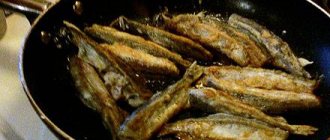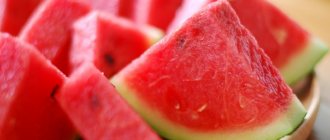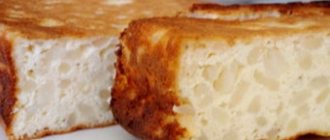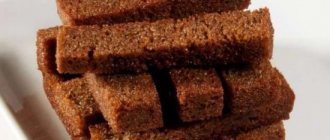How many calories are in different servings:
103
367
| Qty | A portion | Calories | In the counter |
| 1 piece = 28g | 103 | ||
| 100g | 367 | ||
| 59 | 1 cube 2.5 cm = 16g | 59 | |
| 494 | 1 cup diced = 134.67g | 494 | |
| 402 | 1 cup ground = 109.67g | 402 | |
| 104 | 1 ounce = 28.35g | 104 | |
| 103 | 1 piece (1 oz) = 28g | 103 | |
| 77 | 1 slice (3/4 oz) = 21g | 77 | |
| 66 | 1 tablespoon = 18g | 66 | |
| 22 | 1 teaspoon = 6g | 22 |
Contraindications
Edam cheese is a healthy and tasty product
Having many beneficial properties, eating cheese is not recommended for everyone and in some cases can even cause harm to the body. But this can only happen with uncontrolled use of a tasty product in quantities exceeding the permitted consumption.
Contraindications to the use of Edam cheese are:
- allergic reaction and inability to digest dairy products due to the lack of necessary enzymes;
- hypercalcemia;
- excess cholesterol levels in the blood.
Restrictions on use may be in the following cases:
- gastritis, in which acidity increases;
- pyelonephritis, as well as urolithiasis of the kidneys;
- colitis.
An expert will advise you on what to look for when choosing cheese:
https://www.youtube.com/watch?v=AlEO2Bd3BKE
Read along with this article:
- Smoked cheese: calorie content, benefits for the body,…
- Recommendations for making mozzarella cheese, composition and…
- What is the composition and how many calories in Adyghe cheese
- Recommendations on how to prepare cucumaria, information about…
- Coconut milk calorie content, composition, properties
- Foods containing large amounts of protein: benefits for the body
- Useful information: calorie content of mashed potatoes
- About the benefits of salted lard and what contraindications it has...
- What is Mascarpone cheese eaten with, the benefits and harms of the product
Calorie content of related products:
Cheddar Cheese (404cal) Parmesan Cheese (420cal) Cream Cheese (350cal) Shredded Cheese (360cal) Goat Cheese (360cal) Shredded Cheese (420cal) Cheese (318cal) Gouda Cheese (356cal) Hard Cheese ( 392cal.) Cottage cheese (97cal.) Mozzarella cheese (292cal.) Marble cheese (404cal.) Feta cheese (264cal.) Low fat cheese (195cal.) Blue cheese (353cal.) Brie cheese (334cal.) American cheese (371cal.) Processed cheese (364cal.) Brick cheese (371cal.) Camembert cheese (300cal.) Mexican cheese (365cal.) Cheese product (229cal.) Cheese spread (296cal.) Artificial cheese (295cal.) Ricotta cheese (156cal.) .) Cheese topping (370cal.) Cheese substitute (248cal.) Queso Fresco cheese (299cal.) Neuchâtel cheese (253cal.) Provolone cheese (351cal.)
Which cheese is good for weight loss? Calorie content of cheese varieties.
Cheese is a favorite product for many and a valuable addition to the daily diet. There are a huge number of varieties and types of this delicacy, some of which can be included in the weight loss menu. In order not to deny yourself the pleasure of enjoying a couple of pieces of cheese while continuing to lose weight, you need to know which varieties are acceptable to eat during a diet and will help you lose extra pounds.
Composition and beneficial properties of cheese
This product, regardless of variety, contains:
- provitamin A, vitamins E, D, C, PP and group B;
- amino acids not produced in the human body (lysine, methionine and others);
- easily digestible protein;
- micro- and macroelements.
It contains especially a lot of calcium, which is necessary for bone tissue and tooth enamel. The vitamins present in cheese normalize the activity of the central nervous system and participate in the process of hematopoiesis.
The dairy treat helps improve digestion. It is recommended to be consumed as a dessert after a meal. It helps restore metabolic processes, which is especially important for those who want to lose weight and suffer from impaired metabolic rate.
Cheese for weight loss
The average energy value of the product is about 340-370 kilocalories per 100 grams, due to the ratio of milk, starter and rennet. Calorie content did not cause it to be included in the list of foods prohibited for consumption when losing weight.
This is due to the high nutritional value of this dairy product. Eating cheese in small quantities gives you a feeling of fullness and allows you to receive all the substances necessary to maintain normal life.
There are diets for weight loss that involve eating cheese. This is great news for those who cannot do without this product. This is especially true for vegetarians. Giving up meat requires finding an alternative source of protein, which is cheese.
Post Cashew nuts - benefits and harm
It should be remembered that not all cheeses are equally useful for losing weight. This is due not only to calorie content, but also to production technology, which may involve the inclusion of various additives in the product. And in order not to harm your figure, you need to know not only the energy value of different varieties, but also the criteria by which to choose this product.
How many calories are in different types of cheese?
The calorie content of a dairy product is due to the predominance of fats over other macronutrients - proteins and carbohydrates. Cheeses with 50% fat content contain from 360 to 380, and 45% - from 300 to 350 kilocalories.
| Name | Kcal per 100 grams |
| Creamy | 439 |
| Cheddar | 412 |
| Lambert | 377 |
| Sheep | 370 |
| Dutch and Russian | 360 |
| Roquefort | 352 |
| Swiss | 335 |
| Parmesan | 330-389 |
| Bree | 319 |
| Fused | 305 |
Tables cannot fully reflect the energy value of cheese. It depends on the technology and recipe used to produce the dairy product.
Six cheeses for dietary nutrition
The cheeses listed above, from cream to brie, are quite high in calories and are not entirely suitable for those who care about their figure or are on a diet. The best for weight loss are:
- Mozzarella. Its calorie content varies from 160 to 350 kcal. The product made from skim milk has the lowest calorie content. This cheese is easily digestible and even in small quantities can add a unique taste to any dish.
- Adyghe. It has an energy value of no more than 240 kcal. Excellent for preparing vegetable salads, canapés with whole grain bread - dishes that are ideal as dietary dishes. It contains a lot of salt. People prone to swelling are recommended to use it in the first half of the day.
- Feta . One hundred grams of this cheese contains no more than 260 kilocalories. It is practically devoid of carbohydrates, and fats are only partially absorbed from it. Thanks to its original taste, reminiscent of feta cheese, it will be an excellent addition to salads.
- Farmer's. Very similar to the Adyghe one, but not so salty, it can be an excellent replacement for it. This cheese contains approximately 207 kcal. It is used both as an addition to cold appetizers and in the preparation of hot dishes.
- Ricotta. It is prepared not from milk, but from whey. This explains its low calorie content, equal to 174 kilocalories, which does not in any way affect its value for the body. Its main feature is the quick feeling of fullness that a person feels after eating a small amount of ricotta.
- Tofu. A unique product made from soy milk. Due to its plant origin, it contains no more than 90-100 kcal. It is highly valued in cooking because it can be used for absolutely any dish, including desserts.
Post: Useful properties of carrots and carrot juice
There are two more types of cheese, which according to some sources are recommended for inclusion in the diet menu - Camembert and Chechil. The first should be used only by those who keep themselves in shape and are not overweight. The second, having a fat content of 5 to 10%, is very salty and can provoke an increase in appetite.
Which cheese should you choose for your diet menu?
Those who want to lose weight with health benefits need to be careful when choosing cheese. Along with calorie content, you should pay attention to the following points:
- Compound . The modern food industry does not always follow the traditional recipe, including various preservatives and phosphate additives in the composition of the dairy product. They should not be in healthy cheese.
- Fat content. Preference should be given only to low-fat and low-fat types. The same type of cheese may have a higher or lower energy value. The difference sometimes reaches up to 100-200 kilocalories.
- Sugar and flavorings. These components must be absent from the composition. This mainly applies to processed cheese.
It matters not only what kind of cheese is chosen, but also how the product is consumed. People suffering from lactose intolerance can only eat tofu.
How to eat cheese for weight loss?
You should not overuse cheese, especially with a high salt content. Suluguni, feta cheese, and Adyghe cheese can be soaked in water before consumption and eaten only in the first half of the day.
The only cheese that can be eaten without restrictions is tofu. Even a kilogram of low-fat mozzarella or ricotta contains a lot of calories. The optimal daily intake is considered to be from 100 to 200 grams of low-fat cheese.
Diet with processed cheese
Great for people who find it difficult to tolerate strict restrictions. It assumes a monotonous menu consisting of:
- unsweetened tea and processed cheese for breakfast;
- eggs, greens, tomatoes for lunch;
- apples for afternoon snack;
- 250 grams of low-fat cottage cheese, vegetable salad for dinner.
Entry Olive oil on an empty stomach. Benefits of use, disease prevention
You can follow this diet from 5 to 10 days a month to lose 3-5 kilograms.
Summarizing
Cheese is a healthy product that, when consumed in moderation, will be an excellent aid in losing weight. It allows you to get all the necessary nutrients, gives a piquant taste to dishes, which makes it easy to endure deprivations as part of your diet.
Composition of nutrients, BJU
Swiss cheese - 1 piece (28g)
| For quantity: 1 piece | ||
| Calories — 103 | Calories in fat - 70 | |
| BJU | ||
| Total fat content | 7.78g | |
| Saturated | 4.86g | |
| Polyunsaturated | 0.27g | |
| Monounsaturated | 2.09g | |
| Cholesterol | 25.2 mg | |
| Total carbohydrate content | 0.65g | |
| Dietary fiber | 0g | |
| Sugar | 0.24g | |
| Squirrels | 7.48g | |
| Vitamins and microelements | ||
| A - 65.52 µg | C - 0mg | |
| B-6 – 0.02 mg | B-12 - 0.56mcg | |
| D - 0.09 µg | E - 0.12 mg | |
| Calcium 244.72 µg | Iron 0.08 mg | |
| Magnesium 9.15 mg | Zinc 1.11mg | |
| Potassium 37.24 mg | Sodium 146.72 mg | |
Distribution of calories for BJU:Carbohydrates (3%) Fats (68%) Proteins (29%) | ||
Properties of edam cheese
How much does edam cheese cost (average price per 1 kg)?
Moscow and Moscow region.
200 rub.
Edam or Edamer cheese belongs to a group of Dutch cheeses that are made from cow's milk. Edam cheese is classified as hard and semi-hard cheeses, the fat content of which does not exceed 45%. Edamer is distinguished by its spherical shape and pale yellow color; the top of the cheese is coated with paraffin. Gourmets always recognize first-class Dutch Edam cheese by the presence of pronounced nutty notes in the taste of the product.
There are two main types of Edam cheese produced in the Netherlands - young and aged. The taste of young Edam cheese has a sweetish and at the same time mild piquant aftertaste. Aged Edam cheese differs from young Edam cheese in its saltier taste. Additionally, aged or matured Edam cheese has a drier consistency.
Edam cheese received its original name thanks to the city of the same name, which is located in the northern part of Holland. Edam cheese is aged for at least 17 weeks. Elite varieties of cheese are coated with black wax. On the shelves of domestic grocery stores, you can usually find Edamer cheese coated with yellow or red paraffin.
As a result of the research, it was found that Edam cheese was the most popular cheese in the period from the 14th to the 18th centuries. Nowadays, this type of cheese like Edam is popular all over the world. As noted earlier, Edamer cheese contains cow's milk. The cheese mass obtained as a result of the natural fermentation process of milk is placed under a press, under the influence of which whey is released.
At a further stage in the production of Edamer cheese, the product is dried and placed in brine, having previously been rubbed with salt. The minimum ripening period for Edam cheese is one month. After ripening, Edam cheese is coated with paraffin, and elite varieties of the product are coated with beeswax. It is worth noting that seals along the edges of Edam cheese indicate improper storage of the product.










